We may be compensated if you purchase through links on our website. Our team is committed to delivering honest, objective, and independent reviews on home products and services.
You don’t need a backyard farm to enjoy the tangy flavor of just-picked blueberries or the juicy sweetness of vine-ripened tomatoes still warm from the sun. Whether you have a tiny balcony, a small patio, or just a sunny windowsill, there are numerous ways to bring fresh, homegrown produce into your life. This guide will explore various techniques and tips to help you grow fruits and vegetables anywhere.

Shown: Bush beans, eggplant, sage, basil, artichokes, and a container of mint line the backyard path.
Choose the Right Fruit and Vegetable Garden Strategy
Strategize right, and you can grow a lot of food in a tiny space, even in full view of your neighbors. “The first thing is to change your mindset,” says Rosalind Creasy, whose experiments with edible plants in her suburban Los Altos, California, front yard led her to write the classic Edible Landscaping, which was recently updated and reissued. “Think about giving edible plants more status.”
They don’t need to hide in the backyard, for instance, especially if you choose fruit and vegetable varieties with ornamental attributes.
Mixed Greens: The Basics of Small-Space Gardening
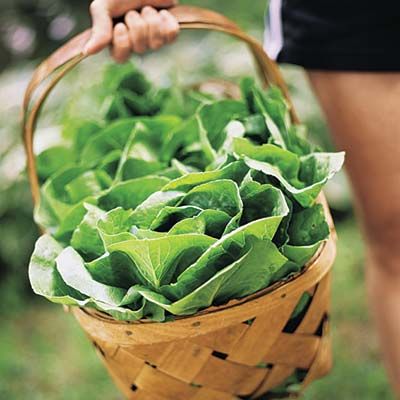
Shown: Lettuce is an easy-to-replenish crop that can be harvested all summer.
First, as Creasy suggests, adjust your mindset—you don’t need to grow food as farmers do. Instead of planting big crops that ripen all at once, tuck in a few seeds or transplants every few weeks so that there’s a continuous food supply. You don’t need long vegetable rows, either. Most edibles actually do better mixed in with different varieties or with flowering plants. Luckily, growing methods that work best for plants also mesh nicely with ways to grow a lot of food in a small space.
When working with limited space, select plants that thrive in confined areas. Look for compact or dwarf varieties of your favorite fruits and vegetables. Many seed companies like Renee’s Garden offer special container vegetable-garden plants that are particularly attractive, productive, and compact.
Some excellent choices for small spaces include:
- Bush varieties of beans and tomatoes
- Compact eggplants
- Herbs like basil, sage, and mint
- Leafy greens such as lettuce, spinach, and Swiss chard
- Dwarf fruit trees like figs or apricots
Remember that mixing different plant varieties or combining edibles with flowering plants can lead to better results. This approach not only maximizes space but also promotes biodiversity and can help deter pests naturally.
Plant in Pots: Container Gardening Vegetables and Herbs
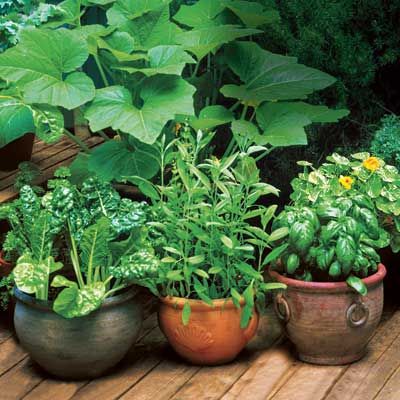
Shown: Swiss chard, bush zucchini, and herbs—including sage, basil, and parsley—all do well in pots.
You can grow most edibles in containers, with caveats. Containers must be sized right and have proper drainage. “Pots less than 6 to 8 inches across are just too much bother,” Creasy says. “The soil dries out too fast.” Heavy, oversize pots can also be problematic if you’re growing dwarf figs, apricots, or other fruit that needs to overwinter in the shelter of an unheated garage or shed. Avoid needing to move anything bigger than a half-barrel, even if you rig up wheels before you plant.
Consider these options for container gardening:
- Large pots or half-barrels for tomatoes, peppers, or dwarf fruit trees
- Window boxes for herbs and salad greens
- Hanging baskets for trailing plants like cherry tomatoes or strawberries
- Strawberry pots with side pockets for herbs, berries, or small vegetables
Ensure all containers have proper drainage holes to prevent waterlogging, which can lead to root rot.
The Right Soil for Growing Food: Potting Mix and Watering
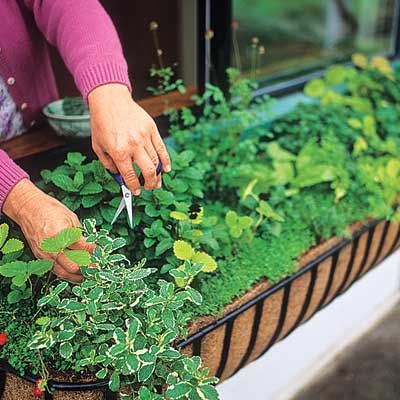
Shown: A window-box herb garden allows for easy snipping.
The success of your container garden largely depends on the quality of your soil. For most edible plants, a high-quality bagged potting mix works best. Avoid using garden soil in containers, as it can become compacted and hinder root growth. Don’t use mixes labeled for starting seeds or growing specific kinds of plants—unless you’re growing blueberries, when the high acidity of a rhododendron-camellia mix is perfect.
When planting, fill your containers with potting mix, leaving about an inch of space at the top for watering. Remember that container plants typically need more frequent watering and fertilizing than those grown in the ground. Check soil moisture regularly and water when the top inch of soil feels dry.
Grow Up: Vertical Vegetable Gardening Techniques

Shown: Cones made of bamboo stakes allow squash to clamber up in a mixed border.
You aren’t limited to what can sprawl along the ground. Vertical gardening is a smart way to maximize your growing space by using existing walls, fences, and other support structures. This technique not only saves ground space but can also create stunning visual displays.
Trained up a trellis, pole peas and beans, cucumbers, small melons, and vining squash all have a small footprint in the garden. A full or half cage made of field fencing is easy to anchor to a container for supporting tomatoes.
For a garden bed, Creasy favors 4×4 posts and hog- or cattle-wire panels, which come in sturdy, flat sections and can support even the heaviest fruit. For either style, get material with 4-inch openings so that you can reach through at harvest time. You can also grow pole beans or cherry tomatoes on a garden arch, which makes harvesting especially easy—just walk through and pluck.
Tasty Plants Overhead: Wall-Mounted and Hanging Gardens
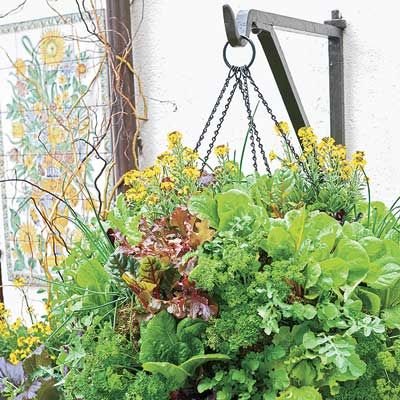
Shown: A hanging pot overflows with salad greens.
Mounting pots on walls, balconies, and roof overhangs also uses vertical space. If your best sun lands on a small area or against a wall, place pots there on a tiered plant stand. There are various systems available, from simple hanging pots to more complex modular setups, including the following.
- Fabric pocket systems that resemble shoe organizers (Plants On Walls)
- Plastic grid systems with angled planting cells (ELT Easy Green)
- Metal mesh panels for attaching small pots (McNichols ECO-Mesh)
When installing wall-mounted gardens, ensure proper drainage to protect your walls from water damage. Consider placing a catch tray beneath the system or directing excess water away from walls, balconies, or foundations.
Raised Beds: Efficient Growing in Small Areas
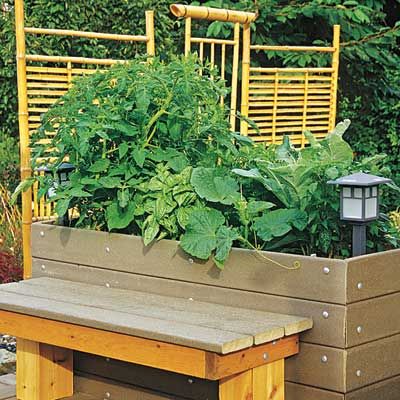
Shown: A bench near a raised bed serves as a knee rest.
A raised bed filled with good soil will warm up and dry out faster in spring, and the added elevation will help keep people from walking across it and compacting the soil or trampling tender shoots. A bed measuring 4 feet square is a good starting point, but you can adjust the dimensions to fit your available area. For beds placed against a wall or fence, aim for a depth of at least 2 feet to allow adequate root growth.
Creating a raised bed is a straightforward DIY project that can significantly enhance your growing space. To build a basic raised bed:
- Choose rot-resistant wood or composite materials for longevity.
- Construct a frame to your desired dimensions.
- Line the bottom with hardware cloth to deter burrowing pests.
- Fill with a mixture of high-quality topsoil, compost, and peat moss.
Pro tip: Grow more food and shade out weeds by staggering plants in all directions and not in rows.
Block It Out: Square Foot Gardening Method
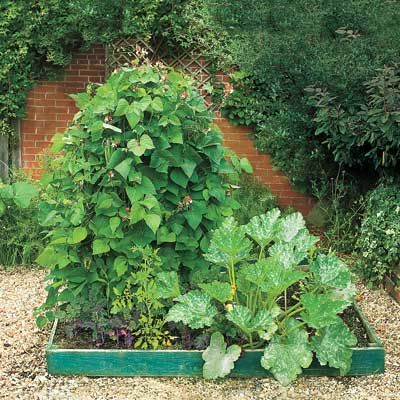
Shown: Trellised runner beans share this bed with zucchini, kale, and tomatoes.
Or follow the advice of Utah gardener Mel Bartholomew, author of the best-selling Square Foot Gardening. Divide your bed into 1-square-foot sections, meaning a bed 4 feet on each side would have 16 sections. Then plant each section individually. As an example, you could:
- Plant one large plant (like broccoli or cabbage) in the center of a square.
- Grow nine medium plants (such as beets or spinach) spaced 4 inches apart.
- Sow 16 small plants (like carrots or radishes) 3 inches apart.
This method allows for diverse planting and makes it easy to rotate crops and replant. Sow new seeds every few weeks, spring through fall, to extend the harvest.
Blend In: Mixing Fruits and Vegetables With Ornamentals
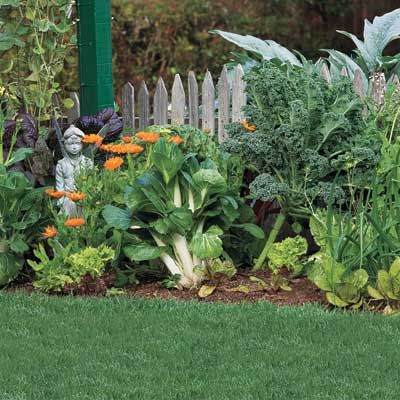
Shown: Curly-leaf kale and bok choy mingle with orange calendula in this mixed border.
Maybe you have outdoor space but it’s already entirely landscaped. To grow food, tuck attractive edibles among the ornamentals or replace what’s there over time. Have a shrub that’s barren in the winter? Switch to a blueberry bush—it’s also bare in winter but has fruit in summer. Genetic dwarf peach cultivars such as ‘El Dorado’ grow just 3 feet high, or taller columnar apple trees can also substitute for existing shrubs. In a perennial border, the huge leaves of rhubarb plants look striking.
You can also mix and match by color. “People ask if they can put that beautiful red-stemmed chard in with red verbena,” Creasy says. “I say, ‘Yes!’ Does that purple cabbage look good with purple pansies? Yes! People gasp at my pictures showing a red wall with purple blackberries hanging down. With roses, people expect beauty. But blackberries are beautiful too. And the thornless kind, such as ‘Black Satin,’ are easy to control.”
Edge Out: Edible Plants as Attractive Borders
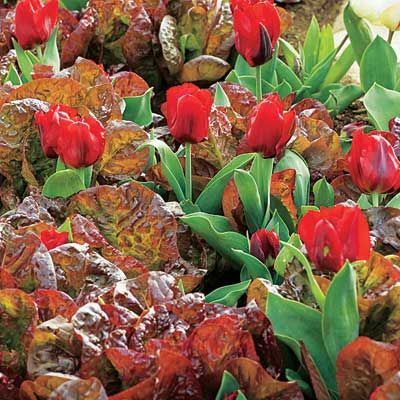
Shown: A stunning display of red leaf lettuce and red tulips.
Many edible plants make excellent border or edging plants, adding both beauty and function to your landscape. Consider these options for garden edges:
- Strawberries, especially alpine varieties that don’t spread by runners
- Low-growing herbs like chives, marjoram, and thyme
- Colorful lettuces or other leafy greens
These plants not only look attractive but also provide easy access for harvesting. In general, choose varieties that keep on giving—for example, broccolis that produce lots of side shoots, so you can cut a few at a time. With leafy greens, such as lettuce, spinach, kale, and chard, pick the largest leaves and allow the small ones to mature for later.
Year-Round Fruit and Vegetable Growing Strategies
With the right techniques, you can extend your growing season and enjoy fresh produce throughout the year, even in less-than-ideal climates.
Succession Planting for Continuous Harvests
Succession planting involves sowing new seeds every few weeks throughout the growing season. This technique ensures a steady supply of fresh vegetables and helps maximize your garden’s productivity.
To implement succession planting:
- Start with fast-growing crops like radishes or lettuce.
- Plant a new batch every two to three weeks.
- As one crop finishes, replace it with a new planting or a different vegetable.
This method works well for many vegetables, including salad greens, beans, and root crops.
Extending the Growing Season in Different Climates
Depending on your climate, you can use various methods to extend your growing season.
- Cold frames or hoop houses to protect plants from frost
- Row covers to provide insulation for cool-season crops
- Heat-loving plants in containers that can be moved indoors during cold spells
- Indoor grow lights for year-round herb and microgreen production
In warmer climates, focus on heat-tolerant varieties during summer and take advantage of the mild winters to grow cool-season crops.
Innovative Edible Gardening Solutions for Urban Spaces
Urban environments present unique challenges for gardeners, but they also offer opportunities for creative growing solutions.
Rooftop and Balcony Gardens
Rooftops and balconies can be transformed into productive growing spaces with the right preparation. Consider these tips:
- Ensure your structure can support the weight of containers, soil, and plants.
- Use lightweight potting mix and containers to minimize weight.
- Install windbreaks to protect plants from strong gusts.
- Choose plants that can tolerate your specific light and wind conditions.
Remember to check with your building management or local authorities regarding any restrictions on rooftop or balcony gardening.
Community Garden Opportunities
If you lack personal outdoor space, community gardens offer a chance to grow your own produce while connecting with fellow gardeners. These shared spaces often provide:
- Individual plots for rent
- Shared tools and resources
- Educational workshops and events
- A sense of community and shared knowledge
Check with your local parks department or community organizations to find community garden opportunities in your area.
Our Conclusion
Growing fruits and vegetables anywhere is not only possible but can be a rewarding and productive endeavor. By embracing small-space gardening techniques, utilizing vertical spaces, and thinking creatively about where and how to grow, you can enjoy fresh, homegrown produce regardless of your living situation. Remember that successful gardening is about experimentation and adaptation. Start small, learn from your experiences, and don’t be afraid to try new methods or plant varieties.
